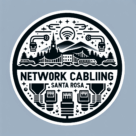What Is a 5 Core Cable? Understanding Its Uses, Benefits, and Applications
If you’ve ever dealt with electrical or networking setups, you might have heard the term 5 core cable. But what exactly is a 5 core cable, and why is it used in so many electrical and industrial applications? In this guide, we’ll break it down in simple terms, explain its benefits, and show where it’s most commonly used. Our team of professional network cabling installers in Santa Rosa ensures that every wiring system, including 5-core cables, meets high safety and performance standards.
What Is a 5 Core Cable?
A 5 core cable is a type of electrical cable that contains five separate insulated conductors (cores) inside a single outer sheath. Each core is usually color-coded for easy identification and carries current for specific purposes, such as live, neutral, earth, or additional phases in three-phase systems.
This type of cable is often used for three-phase power systems, industrial machinery, and certain lighting installations where multiple conductors are needed in one cable.
Key Features of a 5 Core Cable
- Five insulated conductors – Typically color-coded for live, neutral, and earth connections.
- Outer protective sheath – Shields the conductors from environmental damage and electrical interference.
- Variety of sizes – Available in different gauges depending on the current load requirements.
- Durability – Designed for indoor and outdoor use, with heat-resistant and flame-retardant options.
Common Uses of a 5 Core Cable
A 5 core cable is versatile and widely used across residential, commercial, and industrial settings. Some common applications include:
- Three-phase electrical systems – Powers large equipment like motors, HVAC systems, and industrial machinery.
- Lighting installations – Suitable for complex lighting circuits, especially in commercial buildings.
- Control systems – Used in control panels or automation systems requiring multiple conductors.
- Security systems – For CCTV or alarm systems where power and signal cables need to be bundled together.
Benefits of Using a 5 Core Cable
Using a 5 core cable comes with several advantages:
- Simplified wiring – Combines multiple conductors in a single cable, reducing clutter.
- Safety – Color-coded cores make installation easier and minimize wiring errors.
- Durability – Outer sheaths protect against heat, moisture, and mechanical damage.
- Efficiency – Ideal for systems that need multiple electrical paths without running separate cables.
Choosing the Right 5 Core Cable
When selecting a 5 core cable, consider the following factors:
- Current rating – Ensure the cable can handle the load of your system.
- Insulation type – Choose heat-resistant or flame-retardant insulation if required.
- Cable length – Longer runs may need larger gauge cables to prevent voltage drop.
- Application – Determine whether it’s for power, control, or signal use.
Always use cables that comply with local electrical standards and codes to ensure safety and reliability. Before diving deeper into 5-core wiring, it’s helpful to understand what the three wires are commonly used in standard electrical cables.
Conclusion
A 5 core cable is a versatile and efficient way to carry multiple electrical connections in one sheath. From powering three-phase systems to simplifying complex lighting or control circuits, it provides safety, reliability, and durability.
Whether you’re an electrician, contractor, or DIY enthusiast, understanding what a 5 core cable is and how it’s used is essential for planning safe and efficient electrical installations. For data transmission and internet connectivity, it’s also worth learning which cable is used for WiFi to get the best signal performance.
If you’re ready to upgrade or install your electrical system, always consult a licensed electrician to ensure the right cable type, size, and installation methods are used.
